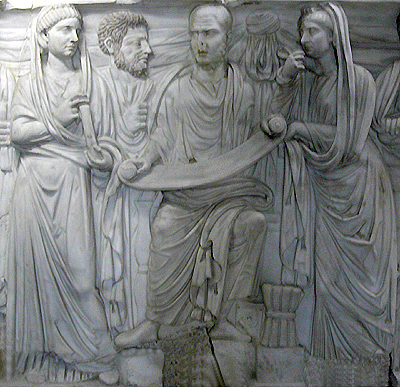 Late Roman/Christian sarcophagus relief (Vatican) |
Gaia Afrania (d. 48 BCE) was born into the the gens Afrania, an old plebeian family. She lived during the chaotic period preceding the breakup of the Republic that saw warring military commanders (Marius, Sulla, Pompey, Caesar) proscribing citizens, manipulating law, and dominating political life. Married to a man who climbed the cursus honorum to enter the Senate at a time of social and political upheaval, she did not wait for male kin to protect her interests, as was traditional for a respectable matron, but argued cases herself. Whatever her husband's reaction to this was, Valerius Maximus' hostile anecdote suggests her legal knowledge and rhetorical ability were successful. Our only other source, the 3rd century CE Roman jurist Ulpian, criticizes her as the cause of the magistrate's edict restricting women from representing others in court-- it is commonly accepted that the reference in Digesta 3.1.1.5 to an immodest and shamelessly demanding Carfrania (improbissima femina . . .inverecunde postulans) is a corruption of C. Afrania. Doubtless the reason was prejudice against women acting in public. Ulpian states the prohibition was intended to keep women from getting involved in the legal business of others, an activity he judges inappropriate to the modesty belonging to their sex (contra pudicitiam sexui congruentem), and from performing male duties (virilibus officiis fungantur mulieres). Afrania appears in Memorabilia 8.3 under the rubric "Which women argued cases before the magistrates for themselves or for others," along with Amesia, who defends herself from a charge, and Hortensia, who pleads before the triumvirs on behalf of the aristocratic matronae against the war tax. Valerius Maximus defines them (see 8.3. Initium) as women who were not restrained from speaking in the Forum and lawcourts by the circumstances of their nature and respect for their stola (condicio naturae et verecundia stolae). While his assessments of Amesia and Hortensia are not negative, he treats Afrania harshly, referring to her as a monstrum. |
| C[aia] Afrania vero Licinii Bucconis senatoris uxor prompta ad lites contrahendas | |
| pro se semper apud praetorem verba fecit, | |
| non quod advocatis deficiebatur, sed quod inpudentia abundabat. | |
| itaque inusitatis foro latratibus adsidue tribunalia exercendo muliebris calumniae notissimum exemplum evasit, | |
| adeo ut pro crimine inprobis feminarum moribus C[aiae] Afraniae nomen obiciatur. | |
| prorogavit autem spiritum suum ad C[aium] Caesarem iterum [Publium] Servilium consules: | |
| tale enim monstrum magis quo tempore extinctum quam quo sit ortum memoriae tradendum est. | |
Click on the underlined words for translation aids and
commentary, which will appear in a small window. Click on the icon link
![]() to the right of the
poem for related images and information.
to the right of the
poem for related images and information.